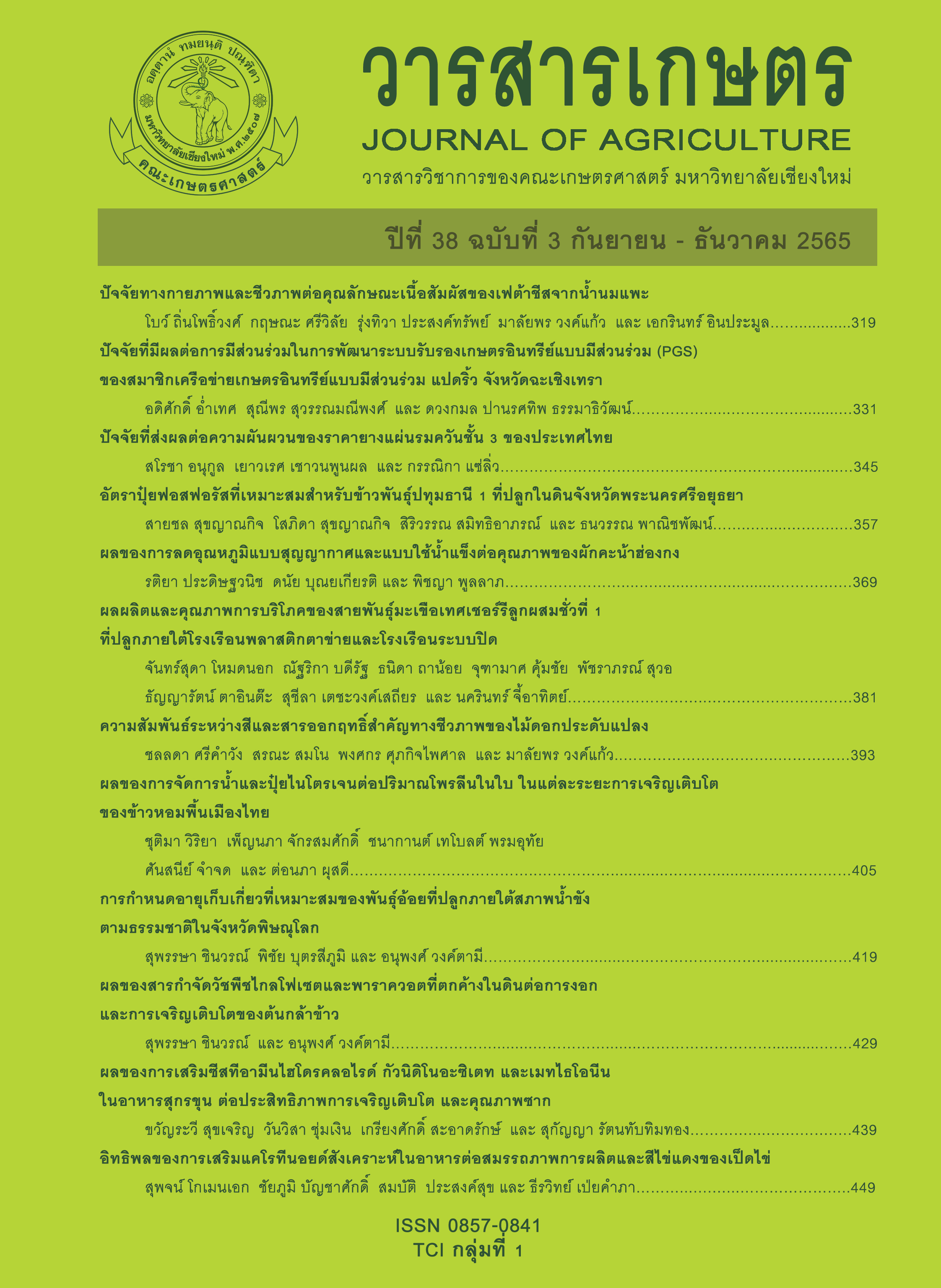การกำหนดอายุเก็บเกี่ยวที่เหมาะสมของพันธุ์อ้อยที่ปลูกภายใต้สภาพน้ำขังตามธรรมชาติในจังหวัดพิษณุโลก
Main Article Content
บทคัดย่อ
อายุเก็บเกี่ยวอ้อยที่แตกต่างกันขึ้นอยู่กับหลายปัจจัย เช่น พันธุ์ สภาพแวดล้อม และการจัดการ เป็นต้น
เมื่ออ้อยอยู่ภายใต้สภาพน้ำท่วมขังอาจจะส่งผลให้มีอายุเก็บเกี่ยวที่เปลี่ยนแปลงไปจากสภาพแวดล้อมปกติ การศึกษานี้มีวัตถุประสงค์เพื่อประเมินอายุเก็บเกี่ยวที่เหมาะสมของพันธุ์อ้อยที่ปลูกภายใต้สภาพน้ำขังตามธรรมชาติ ในจังหวัดพิษณุโลกของประเทศไทย ดำเนินการปลูกทดสอบในฤดูปลูกอ้อยปี 2563/64 ณ แปลงปลูกอ้อยของเกษตรกร ตำบล
บ่อทอง อำเภอบางระกำ จังหวัดพิษณุโลก วางแผนการทดลองแบบ factorial in RCBD จำนวน 4 ซ้ำ ปัจจัยแรก คือ
พันธุ์อ้อย จำนวน 5 พันธุ์ ได้แก่ KPS 07 - 17 - 83, KK07 - 599, KPS 07 - 21 - 4, KK3 และ LK92 - 11 และ ปัจจัยที่สอง คือ อายุเก็บเกี่ยว จำนวน 4 ช่วงอายุเก็บเกี่ยว ได้แก่ เดือนที่ 10, 11, 12 และ 13 หลังปลูก ทำการประเมินและบันทึกข้อมูลผลผลิตอ้อย ผลผลิตน้ำตาล และคุณภาพน้ำอ้อย เมื่ออ้อยอายุ 10, 11, 12 และ 13 เดือนปลูก ผลการศึกษาพบว่า
อ้อยพันธุ์ KPS 07 - 17 - 83, KK07 - 599 และ KPS 07 - 21 - 4 ให้ผลผลิตอ้อย ผลผลิตน้ำตาล และคุณภาพน้ำอ้อยสูงที่สุดในเดือนที่ 13 หลังปลูกเหมือนกัน ซึ่งบ่งชี้ว่าเดือนที่ 13 หลังปลูกนี้เป็นช่วงเวลาที่เหมาะสมสำหรับการเก็บเกี่ยวอ้อยทั้งสามพันธุ์นี้ เพื่อให้ได้ปริมาณผลผลิต และองค์ประกอบผลผลิตที่สูง ภายใต้สภาวะน้ำท่วมขังธรรมชาติของจังหวัดพิษณุโลก จากข้อมูลนี้สามารถนำไปใช้ประกอบการส่งเสริมให้เกษตรกรในจังหวัดพิษณุโลกที่ประสบปัญหาน้ำท่วมขังธรรมชาติปลูกและเก็บเกี่ยวอ้อยทั้งสามพันธุ์นี้ในช่วงเวลาที่เหมาะสมต่อไป
Article Details

อนุญาตภายใต้เงื่อนไข Creative Commons Attribution-NonCommercial-NoDerivatives 4.0 International License.
เอกสารอ้างอิง
Ahmed, A.Z. and A.O. Awadalla. 2016. Effect of harvesting age on yield, yield components and quality of some promising sugarcane varieties. Journal of Plant Production 7(12): 1501-1507.
Boodseephum, P. and A. Wongtamee. 2022. Evaluating yield, yield components, commercial cane sugar and ratooning ability of 14 sugarcane varieties grown under natural water-logged condition in Phitsanulok province. Journal of Agriculture 38(2): 279-292. (in Thai)
Cheavegatti-Gianotto, A., H.M.C. de Abreu, P. Arruda, J.C. Bespalhok Filho, W.L. Burnquist, S. Creste, L. di Ciero, J.A. Ferro, A.V. de Oliveira Figueira, T. de Sousa Filgueiras, M. de Fátima Grossi-de-Sá, E.C. Guzzo, H.P. Hoffmann, M.G. de Andrade Landell, N. Macedo, S. Matsuoka, F. de Castro Reinach, E. Romano, W.J. da Silva, M. de Castro Silva Filho and E.C. Ulian. 2011. Sugarcane (Saccharum X officinarum): A reference study for the regulation of genetically modified cultivars in Brazil. Tropical Plant Biology 4(1): 62-89.
Gomathi, R., P.N. Gururaja Rao, K. Chandran and A. Selvi. 2015. Adaptive responses of sugarcane to waterlogging stress: An over view. Sugar Tech 17(4): 325-338.
Hagos, H., L. Mengistu and Y. Mequanint. 2014. Determining optimum harvest age of sugarcane varieties on the newly establishing sugar project in the tropical areas of Tendaho, Ethiopia. Advances in Crop Science and Technology 2(5): 156, doi: 10.4172/2329-8863.1000156.
Hoang, N.V. 2017. Analysis of genes controlling biomass traits in the genome of sugarcane (Saccharum spp. hybrids). Ph.D. Thesis. The University of Queensland, Brisbane. 218 p.
Fida Hasan, M., M.R. Alam, M.A. Jabber, M.K. Begum and M.A.S. Miah. 2003. Effects of water-logging on juice quality and yield of sugarcane. Pakistan Journal of Biological Sciences 6(13): 1151-1155.
Muchow, R.C., A.J. Higgins, A.V. Rudd and A.W. Ford. 1998. Optimising harvest date in sugar production: A case study for the Mossman mill region in Australia: II. Sensitivity to crop age and crop class distribution. Field Crops Research 57(3): 243-251.
O’Leary, G.J. 2000. A review of three sugarcane simulation models with respect to their prediction of sucrose yield. Field Crops Research 68(2): 97-111.
Reddy, Y.S.K. and K.V.N. Madhuri. 2014. Impact of delayed crush on post-harvest deterioration of promising early maturing sugarcane clones. The Bioscan 9(2): 519-523.
Rungmekarat, S., P. Songsri, A. Wongtamee and T. Chaisan. 2020. Selection of sugar cane cultivars with high yield potential in the lower north, upper central and northeastern regions of Thailand. Research Report. The Office of The Research Fund (TRF), Bangkok. 378 p. (in Thai)
Solomon, S. 2009. Post-harvest deterioration of sugarcane. Sugar Tech 11(2): 109-123.
Sundara, B. 1998. Sugarcane Cultivation. Vikas Publishing House, New Delhi.
Thongviang, V., T. Buphasorn, D. Somrak, P. Phasook, S. Chaluthong, W. Sensai, P. Kokkan, S. Roobsom, O. Yatabe and K. Niimi. 2014. Comparative study of new U-thong sugarcane varieties and locally cultivated varieties in Kumphawapi district, Udon Thani province. Khon Kaen Agricultue Journal 42(2): 231-238. (in Thai)
Tippayawat, A., W. Ponragdee and T. Sansayawichai. 2012. Characteristics of Thai sugarcane (Saccharum spp. hybrids) cultivars and potential for utilization. Khon Kaen Agriculture Journal 40(Suppl. 3): 53-59. (in Thai)
Uppal, S.K., S. Bhatia and K. S. Thind. 2008. Pre milling cane preparation for high sugar recovery and reduction of postharvest losses in sugarcane. Sugar Tech 10(4): 346-349.
Urgesa, G.D. and E.O. Keyata. 2021. Effect of harvesting ages on yield and yield components of sugar cane varieties cultivated at Finchaa sugar factory, Oromia, Ethiopia. International Journal of Food Science 2021: Article ID 2702095, doi: 10.1155/2021/2702095.


